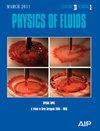混合润滑滑动轴承加速过程局部湍流影响的理论与实验研究
IF 4.3
2区 工程技术
Q1 MECHANICS
引用次数: 9
摘要
由于相对较低的承载能力,低粘度润滑轴承可以很容易地在混合润滑制度下运行。此外,较低的润滑油粘度可能会在相对较厚的膜区引起局部湍流。为了分析局部湍流对混合润滑轴承瞬态特性的影响,提出了一种考虑局部湍流影响的非定常混合润滑轴承仿真方法。利用轴颈动力学方程和数值积分法求解瞬态轴颈中心位置。膜厚与粗糙度的比值决定了轴承的每个节点是处于混合润滑区还是纯流体动力润滑区。用瞬态平均雷诺方程分析了混合润滑区液膜的表面粗糙度效应。采用考虑局部湍流的瞬态广义雷诺方程对流体动力润滑区液膜进行了分析。以一种便于与轴颈中心控制方程耦合的形式导出了瞬态平均雷诺方程和瞬态广义雷诺方程。实验验证了该模型的有效性。分析了局部湍流对非定常混合润滑轴承的影响。结果表明,在低粘度润滑轴承中,即使轴颈转速相对较低,局部湍流和粗糙接触也可以共存。在混合润滑状态下,局部湍流增加了最小油膜厚度,降低了摩擦系数,并降低了混合润滑向流体动力润滑过渡时的轴颈速度。本文章由计算机程序翻译,如有差异,请以英文原文为准。
Theoretical and experimental investigation on local turbulence effect on mixed-lubrication journal bearing during speeding up
Due to the relatively low load-carrying capacity, low-viscosity lubricated bearings can easily operate in a mixed-lubrication regime. Furthermore, low lubricant viscosity may cause local turbulence in the area with relatively thick film. To analyze the influence of local turbulence on the transient characteristics of mixed-lubrication bearings, a simulation approach for unsteady mixed-lubrication bearings considering local turbulence effects is proposed. Transient journal center locations are solved via journal dynamic equations and numerical integration. The ratio of the film thickness to the roughness determines whether each node of the bearing is in the mixed-lubrication area or the pure hydrodynamic lubrication area. The liquid film in the mixed-lubrication area is analyzed by a transient average Reynolds equation to account for the surface roughness effect. A liquid film in the hydrodynamic lubrication area is analyzed by a transient generalized Reynolds equation to consider local turbulence. The transient average Reynolds equation and transient generalized Reynolds equation are derived in a form convenient for coupling with the governing equations of the journal center. The proposed model is experimentally validated. The influence of local turbulence on unsteady mixed-lubrication bearings is analyzed. The results show that local turbulence and asperity contact can coexist in low-viscosity lubricated bearings, even if the journal speed is relatively low. In the mixed-lubrication regime, local turbulence increases the minimum film thickness and decreases the friction coefficient, as well as the journal speed at which the mixed-lubrication transitions to hydrodynamic lubrication.
求助全文
通过发布文献求助,成功后即可免费获取论文全文。
去求助
来源期刊

Physics of Fluids
物理-力学
CiteScore
6.50
自引率
41.30%
发文量
2063
审稿时长
2.6 months
期刊介绍:
Physics of Fluids (PoF) is a preeminent journal devoted to publishing original theoretical, computational, and experimental contributions to the understanding of the dynamics of gases, liquids, and complex or multiphase fluids. Topics published in PoF are diverse and reflect the most important subjects in fluid dynamics, including, but not limited to:
-Acoustics
-Aerospace and aeronautical flow
-Astrophysical flow
-Biofluid mechanics
-Cavitation and cavitating flows
-Combustion flows
-Complex fluids
-Compressible flow
-Computational fluid dynamics
-Contact lines
-Continuum mechanics
-Convection
-Cryogenic flow
-Droplets
-Electrical and magnetic effects in fluid flow
-Foam, bubble, and film mechanics
-Flow control
-Flow instability and transition
-Flow orientation and anisotropy
-Flows with other transport phenomena
-Flows with complex boundary conditions
-Flow visualization
-Fluid mechanics
-Fluid physical properties
-Fluid–structure interactions
-Free surface flows
-Geophysical flow
-Interfacial flow
-Knudsen flow
-Laminar flow
-Liquid crystals
-Mathematics of fluids
-Micro- and nanofluid mechanics
-Mixing
-Molecular theory
-Nanofluidics
-Particulate, multiphase, and granular flow
-Processing flows
-Relativistic fluid mechanics
-Rotating flows
-Shock wave phenomena
-Soft matter
-Stratified flows
-Supercritical fluids
-Superfluidity
-Thermodynamics of flow systems
-Transonic flow
-Turbulent flow
-Viscous and non-Newtonian flow
-Viscoelasticity
-Vortex dynamics
-Waves
 求助内容:
求助内容: 应助结果提醒方式:
应助结果提醒方式:


